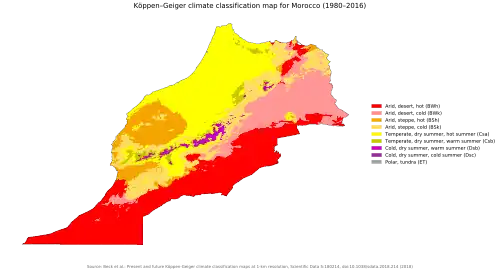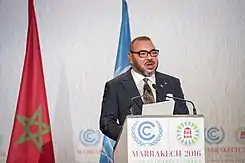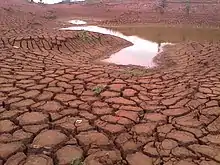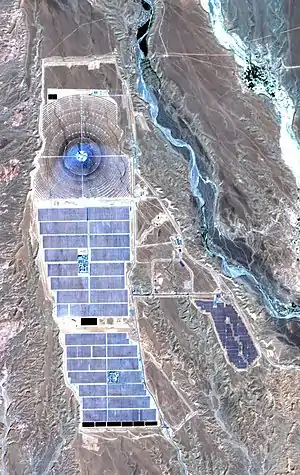Climate change in Morocco is expected to significantly impact Morocco on multiple dimensions, just similar to other countries in the Middle East and North Africa region. As a coastal country with hot and arid climates, environmental impacts from climate change are likely to be wide and varied. Analysis of these environmental changes on the economy of Morocco are expected to create challenges at all levels of the economy. The main effects will be felt in the agricultural systems and fisheries which employ half of the population, and account for 14% of GDP. In addition, because 60% of the population and most of the industrial activity are on the coast, sea level rise is a major threat to key economic forces. Morocco’s average temperatures have increased by 0.2°C per decade since the 1960s.[1] Morocco is particularly susceptible to heat waves, droughts and floods.[2][3]
Morocco ratified the Paris Agreement in 2015. Morocco's Nationally Determined Contribution (INDC) aimed at reducing its greenhouse gas emissions (GHG) by 17% by 2030 compared to business-as-usual (BAU), with the possibility of a reduction of 32% conditional on receiving international support.[4] In June 2021, Morocco submitted an updated NDC with more ambitious targets: reduce GHGs by 18.3% by 2030 compared to BAU, with a reduction of 45.5% conditional on receiving international support.[5][6] Morocco’s contribution to global GHGs is very small (about 0.18%) and majority of GHGs come from the energy sector.[5] As of the 2023 Climate Change Performance Index, Morocco was ranked seventh in preparedness behind Chile.[7]
Greenhouse gas emissions
Morocco has been experiencing exponential growth in its GHGs since the 1960s, with the nation’s emissions reaching 70.58 million metric tons in 2021.[8] This growth is generally following the same trend as the rising population in Morocco, the emissions per capita have stayed relatively steady since the 1910s, staying between 2.1 and 3.5 metric tons per capita every year.[8] However, Morocco has ambitious mitigation plans, and a plan of renewable energy, particularly solar energy. Morocco also aims absorb some of it GHGs through coastal ecosystems.[8][9]
Impacts on the natural environment
Temperature and weather changes


Sea level rise
60% of the population of Morocco lives on the coast, and flooding and sea level rise are expected to significantly effect these populations.[10] These effects are especially going to effect economic activities, including tourism, agriculture, and industry.[10]
Morocco’s rural northeast coast is particularly vulnerable to sea level rise, storm surges and coastal flooding. Some areas in the north coast are eroding at a rate of 1 meter for year.[11] The increase in sea-level rise will affect places such as the low terrain surrounding the Moulouya delta, a vital wetland on the eastern coast of Morocco, that is especially vulnerable to sea-level rise and the stress, flooding, erosion, and overall decimation of the area.[12] The New York Times summarizes the 2022 IPCC climate change assessment, stating that these rising sea levels could "exceed what many nations can afford," both in the sense of destroyed land and economic ramifications.[13]
Water resources
Climate variability is expected to put a number of pressures on water resources in Morocco. Projections indicate 10%-20% decreases in precipitation across the country, with the most severe in the Saharan region by 2100.[10] Additionally, climate change will reduce snowpack in the Atlas Mountains.[10] This puts pressure on water resources, already stressed by other sources such as population expansion, urban growth, industry, and tourism.[10] Furthermore, many coastal aquifers will increasingly become stressed because of coastal salinization.
Of the 140 billion cubic meters of water which fall on Morocco yearly, 118 BCM are lost to evaporation before they can be used by the communities.[14]
Morocco experienced an unprecedented heat wave in spring 2022, with temperatures far above the seasonal average, attributed to climate change. A dry winter and a five-year trend of declining annual rainfall have contributed to severe water scarcity and adversely affected the agricultural sector. The rise in temperatures is linked to increased greenhouse gas emissions, deforestation, and urbanization.[15]
Imider, a water-stressed community in Morocco's southeast, faces climate change-induced water scarcity. The indigenous Amazigh people have traditionally depended on an efficient irrigation system known as 'khettara,' but rising temperatures and drought, along with phosphate and silver mining in the region, threaten this centuries-old method.[16]
Ecosystems
Climate change will adversely affect Morocco's marine and terrestrial ecosystems: A complete lack of germination for cedar trees has been observed and their populations are already declining because of their struggle to find soils which they can germinate and sprout in.[17] Oasis ecosystems are complex and fragile, but they have historically thrived in Morocco due to the arid climate and rare rainfall.[18] The Middle Drâa valley is one of the most vital Oasis’ in Morrocco, making up 15,000 km3 of environment. The soils found in these systems are very fertile because they were formed in river deltas, and they have been used for farmland. Farming on this land has now become extremely water intensive and motives have moved to restoring the natural ecosystem in hopes of regenerating biodiversity and saving water.[19]
There has also been a notable loss in ocean plants. Coral and sea grasses are not able to survive in the Mediterranean's rising temperatures. All these things are carbon sinks, and their loss is only worsening climate change.[20] Lagoon systems face a heightened risk to sea level rise across Morrocco. The Nador Lagoon is one of the largest in Morrocco, block from the high salinity of the Mediterranean by a barrier which averages 350m in width. These lagoons are vital to the protection of the mainland coastline.[21]
Impacts on people
Economy
Agriculture
The agricultural system in Morocco is especially vulnerable to climate change. Crop production is primarily (87%) from rainfed agriculture.[10] A 2016 drought resulted in 70% decreases in crop yields, and slowed the economy.[10]
Morocco struggles with malnutrition and has a diet which consists of 58% in volume wheat products and bread.[22] This part of the diet is extremely important both culturally and for the people's choleric intake, being 71% of daily calories for the average person living in Morocco.[22] To meet this large demand, Morocco is forced to import 40% of their wheat products, which takes away from the industry within the State, and sends their income to other countries where they could be holding more wealth in their own country if it weren't for the difficulty, they see with water scarcity.[22]
Tourism
Tourism is the second largest contributor to GDP in Morrocco, but the industry is declining due to the effects which climate change is having on the area. Increasing temperatures are expected to diminish the popularity of Morocco as a tourist destination. Sea level rise is also expected to damage more infostructure in the coming years, much of which is used for tourism purposes.
Health impacts
“Increased heat and extreme heat conditions results in significant implications for human and animal health in Morocco, including the increased risk of mortality, resurgence of Malaria, increased risk of leishmaniasis, as well as the introduction of other vector-borne diseases including Zika. Flooding will also increase the risk of death, and droughts will increase the risk of infectious diseases. A recent WHO study, using a high-emissions scenario, projected heat related death in the elderly population aged sixty-five years and older in Morocco to increase to almost fifty deaths per 100,000 inhabitants by 2080, compared to the current baseline of five death by 100,000 inhabitants.”[23]
Mitigation and adaptation
Renewable energy
Morocco identified the transport, household energy, industry, livestock, and energy sectors as priority areas for mitigation.[24] Morocco is dependent on imported fossil fuels, such as coal, oil and gas, and 80% of its energy in 2020 came from these imported fossil fuels.[25] In 2022, fossil fuels are the country’s most prominent energy source, providing around 90% of Morocco’s energy needs.[26] Morocco is accelerating the replacement of coal and gas in its electricity mix. Renewable energy technologies are one of the key pillars in Morocco’s mitigation strategy.[25] Renewables account for about 37.08%, with wind power contributing the highest amount, at 13.37%, followed by solar at 7.58%, and finally, hydropower at 16.14%.[26] In 2018, the Moroccan Agency for Sustainable Energy (MASEN), the First National Operation & Maintenance Company (NOMAC), and the International Company for Water and Power Projects (ACWA Power) completed construction of the 582 MW Noor Ouarzazate Solar Complex. Included in the complex are the world’s largest concentrated solar power (CSP) facility (510 MW) and a 72 MW photovoltaic facility (PV) (completed in 2016).[27] The plant is able to deliver power into the evening hours by using molten salt thermal energy storage.[28] Despite the site’s major energy production, the development phase was reportedly problematic, where the developers did not effectively engage with the community and compromised the local water source.[29]
In 2021, Morocco released an updated version of its Paris Agreement Nationally Determined Contribution (NDC), which aims for renewables to account for 52% of installed electrical power by 2030.[26][30] Individual targets are set at 20% solar, 20% wind, 12% hydroelectric, and a 20% savings in energy consumption.[30] The new NDCs aim to not only contribute to a lower greenhouse gas impact, but to increase Morocco’s energy security, as the majority of its fossil fuels are imported (near 90% in 2022).[26]
Moreover, Morocco’s state-owned energy utility, National Office of Electricity and Drinking Water (ONEE), which owns all operations and transmission lines for Morocco’s power grid, has overseen some major installments of renewable energy production facilities. Currently, around 16 renewable energy projects have been installed, with 32 in plans.[27]
Construction of a 350 MW Pumped Energy Transfer Station (PETS) in the town of Abdelmoumen, located some 70 km from Agadir, began in April 2018 and was set to complete in 2022 (status unclear at the time of writing).[26][31][32][33] Morocco’s ONEE energy utility owns the project, and contractors Vinci Construction and Andritz Hydro were brought on for construction and operation.[31] Worth nearly $317 million, plant serves as a rapid-response energy facility that will provide around 616 GWh per year to Morocco’s southern region of Souss-Massa-Drâa.[31]
Energy policy
Morocco's energy policy is set independently by two agencies of the government: the Office of Hydrocarbons and Mining (ONHYM)[34] which sets domestic oil policy, and the Office National de l'Electricité (ONE),[35] which sets policy with regard to electricity. The two major weaknesses of the energy policy of Morocco are the lack of coordination between these two agencies and the lack of development of domestic energy sources.[36]
The country has some hydrocarbon reserves, mostly in natural gas reserves that have been exploited. Currently, most energy is produced through hydrocarbon thermal plants. However, government policy is on track to convert to a high renewable mix of 42% installed renewables by 2020, and 52% by 2030.[37] Renewables include hydroelectric, wind, and solar.Government policies and legislation

Morocco ranked second in its approach to addressing climate change in the 2018 and 2019 Climate Change Performance Index.[38][39][40] As per the 2022 CCPI, Morocco was ranked 8th amongst the 68 countries around the world with an overall score of 71.64%.[41]
The government of Morocco has a Plan Verde strategy in order to cope with climate change.[42] In this plan, the government commits to producing over half of its energy by renewables by 2030, removing subsidies of fossil fuels, committing to green employment, focusing on ocean resource management and preserving aquifers.[42]
Morocco intends to generate 52 percent of its electricity from renewable sources by 2030, with 20 percent coming from solar, 20 percent from wind, and 12 percent from hydropower.[43]
In 2023, Morocco's finance minister, Nadia Fettah Alaoui, highlighted the need to adapt the country's economy to address the escalating threat of climate change. Droughts caused by below-average rainfall linked to climate change have significantly impacted Morocco's agriculture, and the country's economy grew just 1.2% in 2022, down from 7.9% the previous year. To address the water scarcity challenge, the government is focusing on investing in water technologies and further accelerating growth sectors like car manufacturing.[44]
See also
References
- ↑ "CHAPTER 7: Climate Change and Development in Morocco", Morocco’s Quest for Stronger and Inclusive Growth, International Monetary Fund, 9 October 2023, ISBN 979-8-4002-2540-6, retrieved 2023-11-04
- ↑ Philip, S.; Kew, S.; Vautard, R.; Vahlberg, M.; Singh, R.; Driouech, F.; Lguensat, R.; Barnes, C.; Otto, F. (2023-05-05). Extreme April heat in Spain, Portugal, Morocco & Algeria almost impossible without climate change (Report). doi:10.25561/103833. hdl:10044/1/103833.
- ↑ "CHAPTER 7: Climate Change and Development in Morocco", Morocco’s Quest for Stronger and Inclusive Growth, International Monetary Fund, 9 October 2023, ISBN 979-8-4002-2540-6, retrieved 2023-11-04
- ↑ "Morocco - Intended Nationally Determined Contribution (INDC) Under The UNFCCC" (PDF). Climate Vulnerable Fund. 2016. Retrieved 2023-11-03.
- 1 2 "Morocco Submits Enhanced NDC, Raising Ambition to 45.5 Percent by 2030 |". ndcpartnership.org. Retrieved 2023-11-04.
- ↑ "Nationally Determined Contribution - Updated". unfccc.int. 22 June 2021. Retrieved 2023-11-04.
- ↑ "Ranking | Climate Change Performance Index". 2022-11-14. Retrieved 2023-11-04.
- 1 2 3 Ritchie, Hannah; Roser, Max; Rosado, Pablo (2020-05-11). "CO₂ and Greenhouse Gas Emissions". Our World in Data.
- ↑ Melaku Canu, Donata; Ghermandi, Andrea; Nunes, Paulo A. L. D.; Lazzari, Paolo; Cossarini, Gianpiero; Solidoro, Cosimo (2015-05-01). "Estimating the value of carbon sequestration ecosystem services in the Mediterranean Sea: An ecological economics approach". Global Environmental Change. 32: 87–95. doi:10.1016/j.gloenvcha.2015.02.008. ISSN 0959-3780.
- 1 2 3 4 5 6 7 "Climate Risk Profile: Morocco". Climatelinks. 9 December 2016. Retrieved 2020-05-13.
- ↑ "Morocco | National Adaptation Global Support Programme". www.globalsupportprogramme.org. Retrieved 2023-11-04.
- ↑ Snoussi, Maria; Ouchani, Tachfine; Niazi, Saïda (2008-04-10). "Vulnerability assessment of the impact of sea-level rise and flooding on the Moroccan coast: The case of the Mediterranean eastern zone". Estuarine, Coastal and Shelf Science. 77 (2): 206–213. Bibcode:2008ECSS...77..206S. doi:10.1016/j.ecss.2007.09.024. ISSN 0272-7714.
- ↑ Plumer, Brad; Zhong, Raymond (2022-02-28). "Climate Change Is Harming the Planet Faster Than We Can Adapt, U.N. Warns". The New York Times. ISSN 0362-4331. Retrieved 2022-02-28.
- ↑ "Water Resources in Morocco". Fanack Water. Retrieved 2023-11-04.
- ↑ Nait el-Rayes, Soukina. "Dry Winters and Scorching Springs: Climate Change in Morocco". Carnegie Endowment for International Peace.
- ↑ Santarsiero, Rachel (2023-06-30). "Morocco's centuries-old irrigation system under threat from climate change". Climate Home News. Retrieved 2023-10-24.
- ↑ Ilmen, R.; Sabir, A.; Benzyane, M.; Karrouk, M. S. (2014-11-18). "Variability and dynamic response of the cedar to climate change in the Eastern Middle Atlas Mountains, Morocco". Moroccan Journal of Chemistry. 2 (5): 2–516. doi:10.48317/IMIST.PRSM/morjchem-v2i5.2428. ISSN 2351-812X.
- ↑ "Photos: Climate crisis threatens centuries-old oases in Morocco". Al Jazeera. Retrieved 2023-11-14.
- ↑ Moumane, Adil; Al Karkouri, Jamal; Benmansour, Adnane; El Ghazali, Fatima Ezzahra; Fico, Jamie; Karmaoui, Ahmed; Batchi, Mouhcine (2022-04-01). "Monitoring long-term land use, land cover change, and desertification in the Ternata oasis, Middle Draa Valley, Morocco". Remote Sensing Applications: Society and Environment. 26: 100745. Bibcode:2022RSASE..2600745M. doi:10.1016/j.rsase.2022.100745. ISSN 2352-9385. S2CID 247969375.
- ↑ Pergent, G.; Bazairi, H.; Bianchi, C. N.; Boudouresque, C. F.; Buia, M. C.; Calvo, S.; Clabaut, P.; Harmelin-Vivien, M.; Mateo, M. A.; Montefalcone, M.; Morri, C.; Orfanidis, S.; Pergent-Martini, C.; Semroud, R.; Serrano, O. (2014-02-28). "Climate change and Mediterranean seagrass meadows: a synopsis for environmental managers". Mediterranean Marine Science. 15 (2): 462–473. doi:10.12681/mms.621. ISSN 1791-6763.
- ↑ Raji, Otmane; Niazi, Saida; Snoussi, Maria; Dezileau, Laurent; Khouakhi, Abdou (1 April 2013). "Vulnerability assessment of a lagoon to sea level rise and storm events: Nador lagoon (NE Morocco)". Journal of Coastal Research. 65 (sp1): 802–807. doi:10.2112/SI65-136.1. ISSN 0749-0208. S2CID 73608686 – via BioOne.
- 1 2 3 Santos, Nuno; Ceccacci, Iride (2015). "Egypt, Jordan, Morocco and Tunisia: Key trends in the agrifood sector" (PDF). Rome: Food and Agriculture Organization of the United Nations. Food and Agriculture Organization of the United Nations.
- ↑ "Climate profile: Morocco". Atlantic Council. Retrieved 2023-11-04.
- ↑ "Morocco's National Action Plan Signals New Era in the Country's Climate and Clean Air Commitment | Climate & Clean Air Coalition". www.ccacoalition.org. Retrieved 2023-11-04.
- 1 2 "Climate Resilience for Energy Transition in Morocco – Analysis". IEA. Retrieved 2023-11-04.
- 1 2 3 4 5 "Morocco - Energy". www.trade.gov. Retrieved 2023-11-04.
- 1 2 "Power Sector Transition in Morocco". Global Energy Monitor. Retrieved 2023-11-04.
- ↑ "NOORO I CSP IPP". ACWA Power.
- ↑ Douglas, Georgia (2021-03-21). "Shining a Light on the Injustices of the Noor Ouarzazate Solar Plant Empoword Journalism Global". Empoword Journalism. Retrieved 2023-11-04.
- 1 2 "Nationally Determined Contribution - Updated" (PDF). unfccc.int. June 2021. Retrieved 2023-11-04.
- 1 2 3 "Abdelmoumen Pumped-Storage Power Plant, Morocco". Retrieved 2023-11-04.
- ↑ "Abdelmoumen pumped storage hydroelectric plant". VINCI Construction Grands Projets. Retrieved 2023-11-04.
- ↑ "Morocco's Second Energy Transfer Pumping Station to See Light in Agadir". Morocco World News. Morocco World News. 9 October 2018. Retrieved 2023-11-03.
- ↑ "Home". Office of Hydrocarbons and Mining. Retrieved 2020-10-22.
- ↑ "Branche Electricité". Site web officiel de l'ONEE. Retrieved 2020-10-22.
- ↑ Choukri, Karim; Naddami, Ahmed; Hayani, Sanaa (2017-09-04). "Renewable energy in emergent countries: lessons from energy transition in Morocco". Energy, Sustainability and Society. 7 (1): 25. doi:10.1186/s13705-017-0131-2. ISSN 2192-0567.
- ↑ "MOROCCO: Ranked second worldwide in climate change control". Afrik 21. 2020-04-30. Retrieved 2020-05-29.
- ↑ "Morocco ranked second in Climate Change Performance Index 2018". UN Environment. 2018-12-20. Retrieved 2020-05-13.
- ↑ "Morocco: Ranked second worldwide in climate change control". Afrik 21. 2020-04-30. Retrieved 2020-05-29.
- ↑ "Climate Change Performance Index 2022: Morocco maintains its rank in the top 10 worldwide – The North Africa Post".
- ↑ Latrech, Oumaima. "2022 Climate Change Performance Index: Morocco 5th Best Country Worldwide". Morocco World News.
- 1 2 "5 things Morocco is doing about Climate Change". World Bank. Retrieved 2020-05-13.
- ↑ Falk, Thomas O. "Morocco: MENA's rare climate change success story". www.aljazeera.com. Retrieved 2023-10-24.
- ↑ Saleh, Heba (2023-03-12). "Morocco must adapt to growing climate threat, warns finance minister". Financial Times. Retrieved 2023-10-24.

